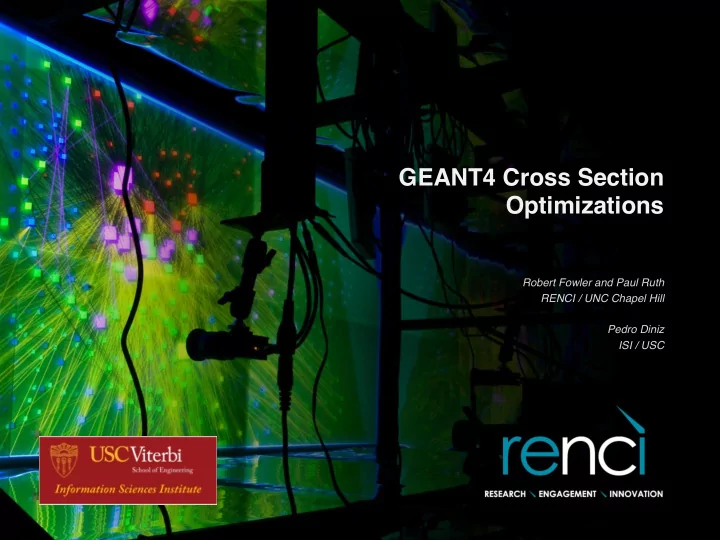

GEANT4 Cross Section Optimizations � Robert Fowler and Paul Ruth � RENCI / UNC Chapel Hill � � Pedro Diniz � ISI / USC � �
Updates to Cross Section Code � • Revised GetCrossSection(part,mat) Method: � G4double G4CrossSectionDataStore::GetCrossSection(part,mat){ � ... � if((part == part_ref)&&(mat == mat_ref)&&(this->proc == proc_ref)){ � rslt = getCrossSectionTable(hash(part_ref, mat_ref, proc_ref, energy); � clear xssecelem(); � return rslt; � } else { � // --- regular code filling in xsecelem; � } � ... � } � � G4double G4CrossSectionDataStore::SampleZandA(part,mat){ � ... � if(isEmptyXSECELEM()){ � // --- compute the various cross section per element of the material � // this is the lazy evaluation of the xsecelem � } � ... � } � ¡
Updates to Cross Section Code � • Short-Term Code Update � – Minor modifications of the G4CrossSectionDataStore class objects and methods (.hh and .cc codes in /source/process/ hadronic/crosssections) � – Inclusion of references to Physics Process (both G4String and Enumerated data Fields � – Initialization Method uses externally-provided table with selected particles, material and physics’ process � – Uses Segmented table-based interpolation to compute the cross section functions (lazily for materials’ elements if needed) � – Pick subset of (particle, material, process) to demonstrate performance improvement. � • Medium-Term Code Update � – Initialization Method indicating which Particle, Material and Process can use predefined table (controlled by command file) � – Load predefined file or generate on the fly. �
Cross Section Usage � • Particle/Material Pairs � – 50% of calls in ~10 particle/material pairs � – 90% of calls in ~40 particle/material pairs � – Observed ~4k pairs � • Particle/Material/Process Triples � – 50% of cycles in ~10 triples � – 90% of cycles in ~85 triples � – Observed ~18k triples � • Implementing fast path for tens of pairs (or triples) can speedup the nearly all of the calls. � 4 �
Par9cle: ¡neutron ¡ Fast Path Usage � Material: ¡materials_StainlessSteel ¡ Process: ¡G4Neutron ¡Inelas9cXS ¡ Slow path only: � Cycles ¡ Calls ¡ Cycles/Call ¡ Slow ¡Path ¡ ¡ 6,133,110,476 ¡ 6,278,517 ¡ ¡ 977 ¡ ¡ Fast path with lazy computation of slow path: � Cycles ¡ Calls ¡ Cycles/Call ¡ Slow ¡Path ¡ 223,362,860 ¡ 94,876 ¡ 2,354 ¡ Fast ¡Path ¡ 1,059,541,332 ¡ 5,887,001 ¡ 179 ¡ ¡ Total ¡ 1,282,904,192 ¡ ¡ 5,981,877 ¡ 214 ¡ ¡ Possible ~5x speed up of cross section calculation � 5 �
Additional Observation � • Observation � – Multiple calls to GetCrossSection with exactly the same particle, material, process, and energy � – Results in same cross section result � • Optimization � – Cache recent cross section for particle, material, process triple. � • Measurements � – 17% of calls would benefit from this cache � – 29% of GetCrossSection cycles are from these calls. � – ~18k triples (probably can’t cache all of them) � – ~3k triples would need cache (still too many) � 6 �
Recommend
More recommend